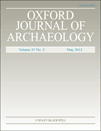
Oxford Journal of Archaeology
Scope & Guideline
Fostering Collaboration in the Archaeological Community
Introduction
Aims and Scopes
- Material Culture Analysis:
The journal emphasizes the analysis of artifacts, structures, and landscapes to understand ancient societies. This includes studies on pottery, metalwork, and other material remains. - Interdisciplinary Approaches:
Research published in the journal often employs interdisciplinary methodologies, integrating archaeology with fields such as anthropology, history, and environmental science. - Cultural and Social Contexts:
A core focus is on the cultural and social contexts of archaeological finds, exploring how material culture reflects social structures, ideologies, and practices of past communities. - Chronological and Regional Diversity:
The journal covers a wide chronological range from prehistoric to historic periods, as well as diverse geographical regions, including the Mediterranean, Near East, and Northern Europe. - Technological Innovations:
It features studies that apply new technologies in archaeology, such as digital mapping, isotopic analysis, and materials science, enhancing the understanding of archaeological contexts.
Trending and Emerging
- Community and Identity Studies:
There is a growing focus on how material culture relates to community identity and social dynamics, emphasizing the role of artifacts in constructing and expressing group identities. - Environmental Archaeology:
Research linking archaeology with environmental studies is on the rise, exploring how ancient peoples interacted with their environments, including climate change impacts and resource management. - Digital Archaeology and Data Visualization:
The integration of digital tools and data visualization techniques is becoming more prominent, enhancing the accessibility and interpretative potential of archaeological data. - Gender and Agency in Archaeology:
Emerging studies increasingly address issues of gender, agency, and social roles within past societies, reflecting broader societal discussions on these topics. - Cultural Hybridity and Contact:
Research focusing on cultural exchanges, hybridity, and the impacts of contact between different societies is trending, illustrating the complexities of interaction in archaeological contexts.
Declining or Waning
- Traditional Excavation Reports:
There has been a noticeable decrease in publications focusing solely on traditional excavation reports, as the field increasingly values interpretive analyses over mere description of findings. - Art Historical Approaches:
Research that primarily focuses on art historical analysis of artifacts without integrating broader archaeological context appears to be less prevalent, as the journal encourages more holistic studies. - Single-Culture Studies:
There is a waning interest in studies that concentrate exclusively on single cultures or isolated sites, with a growing trend towards comparative and cross-cultural analyses. - Descriptive Typologies:
The decline in purely descriptive typological studies suggests a shift towards more interpretative frameworks that contextualize artifacts within their societal and cultural landscapes.
Similar Journals

Intersecciones en Antropologia
Advancing anthropological dialogue across borders.Intersecciones en Antropologia, published by the Universidad Nacional del Centro de la Provincia de Buenos Aires (UNICEN), Facultad de Ciencias Sociales, is a premier open-access journal in the field of anthropology, having established its presence since 2010. With an impressive impact factor and currently holding the distinguished Q1 quartile ranking in anthropology for 2023, this journal has quickly become a vital resource for scholars and practitioners alike, offering a platform for innovative research and critical discussion. The journal aims to advance anthropological scholarship by encouraging the dissemination of diverse perspectives and stimulating dialogue across geographical and cultural boundaries. Its open-access model, adopted in 2017, ensures that valuable research findings are accessible to a global audience, fostering collaboration and engagement within the academic community and beyond. Located in the vibrant cultural context of Argentina, Intersecciones en Antropologia serves as a conduit for significant anthropological dialogues, making it an essential read for those dedicated to understanding and contributing to the evolving landscape of social sciences.
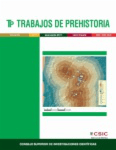
Trabajos de Prehistoria
Connecting Scholars Worldwide to Unravel the Mysteries of Human HistoryTrabajos de Prehistoria is a distinguished peer-reviewed journal published by the Consejo Superior de Investigaciones Científicas (CSIC) since 1988, and it has established itself as a vital resource in the field of archaeology and prehistory. With an impressive impact factor and an open access policy, the journal aims to disseminate high-quality research that contributes to the understanding of human history and prehistorical studies. This Spanish journal has consistently ranked in the top quartile (Q1) in both the Arts and Humanities and Social Sciences categories, reflecting its significance in advancing archaeological scholarship, with Scopus rankings placing it in the 85th percentile among its peers. Covering a broad scope of topics related to archaeology, it serves as a platform for innovative research that connects researchers, professionals, and students globally, enhancing academic dialogue and fostering interdisciplinary collaboration. Based in Madrid, European researchers and global academics alike benefit from its open access model, promoting wider distribution and accessibility of foundational studies in the field.
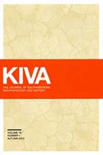
Kiva-Journal of Southwestern Anthropology and History
Advancing Knowledge in Anthropology and HistoryKiva - Journal of Southwestern Anthropology and History is a distinguished academic journal published by Routledge Journals, Taylor & Francis Ltd, that serves as a vital resource for scholars in the fields of anthropology, archaeology, and history. With an ISSN of 0023-1940 and an E-ISSN of 2051-6177, this journal has established itself as a significant avenue for scholarly communication since its inception in 1964. It consistently ranks in the top quartiles, including Q1 in Archaeology and Q2 in Anthropology, reflecting its high impact and rigorous peer-review process. Covering a wide array of topics pertinent to the Southwestern United States, Kiva invites original research articles, reviews, and methodological papers that advance understanding of the region's rich cultural heritage and historical narratives. While currently not open access, its commitment to disseminating quality research makes it an essential reading for researchers, professionals, and students aiming to explore the multifaceted dimensions of southwestern studies.

Slovenska Archeologia
Connecting scholars to the treasures of Slovakia's archaeological landscape.Slovenska Archeologia is a prominent journal published by the Slovak Academy of Sciences, Institute of Archaeology, dedicated to advancing the field of archaeology through rigorous scholarly research and insightful scholarship. With an ISSN of 1335-0102 and an E-ISSN of 2585-9145, this journal has been a vital platform for archaeologists and academics since its inception, converging its insightful publications from the years 2017 to 2023. Awarded a Q2 ranking in the field of archaeology across both arts and humanities categories, it holds a respectable position in the Scopus rankings, recognizing its contributions to the discipline. Based in Slovakia, the journal is an essential resource for professionals, researchers, and students interested in archaeological findings and methodologies. While it does not currently offer Open Access options, its commitment to promoting high-quality research makes it a valuable addition to the academic community.
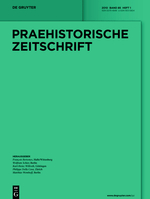
Praehistorische Zeitschrift
Championing Scholarly Excellence in Prehistoric ResearchPraehistorische Zeitschrift is a premier scholarly journal dedicated to the field of archaeology, published by WALTER DE GRUYTER GMBH in Germany. With a rich history dating back to 1909, the journal has evolved to encompass a wide range of topics pertaining to prehistory, offering vital insights into archaeological practices, theories, and discoveries. Recognized as a Q1 journal in both the Archaeology category of Arts and Humanities and the Social Sciences, it holds a prestigious position with Scopus rankings placing it in the top 20% of its field. Although it operates under a traditional publishing model without open access, its comprehensive articles are essential reading for researchers, professionals, and students alike who seek to deepen their understanding of prehistoric studies through rigorous academic contributions. The journal continues to publish significant research from 1993 to 2024 and beyond, making it an indispensable resource for anyone interested in the archaeological narrative of humanity.
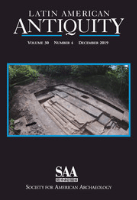
LATIN AMERICAN ANTIQUITY
Charting New Territories in Latin American Archaeological StudiesLATIN AMERICAN ANTIQUITY is a prestigious journal published by Cambridge University Press, focusing on the archaeology and history of Latin America. With an impressive impact factor reflecting its critical role in the academic community, this journal exemplifies excellence in research, landing in Q1 across multiple categories, including Archaeology and History, as per the 2023 category quartiles. The journal's scope covers a broad range of topics related to pre-Columbian cultures, ancient civilizations, and historical developments, making it essential reading for researchers, professionals, and students keen on exploring the rich tapestry of Latin American heritage. Although it is not an open-access publication, LATIN AMERICAN ANTIQUITY remains a vital resource for those dedicated to advancing knowledge in this dynamic field. With its commitment to scholarly rigor and a strong ranking in Scopus, it serves as a cornerstone for academic dialogue and investigation.

Adalya
Advancing Knowledge in Archaeology and Cultural PreservationAdalya, published by the esteemed Koc University Suna & Inan Kirac Research Center for Mediterranean Civilizations (AKMED), is a prominent academic journal dedicated to the fields of Archeology, History, and Conservation. With an ISSN of 1301-2746, this journal serves as an essential platform for scholars and researchers, fostering insightful discussions and disseminating significant findings about Mediterranean civilizations. Recognized in the quartile rankings of Q3 in Archeology and Q2 in both Conservation and History for the year 2023, Adalya reflects an impactful presence in its respective disciplines. Although it operates under a traditional subscription model, the journal remains accessible to a diverse audience interested in the nuanced exploration of historical contexts and conservation practices. Located in Antalya, Turkey, the journal has carved out a niche since its inception in 2009, bridging the past and present through rigorous academic inquiry. Whether you are a seasoned researcher or a student eager to deepen your understanding of Mediterranean cultures, Adalya offers invaluable resources and perspectives that enrich the academic community.

Archaeological and Anthropological Sciences
Exploring Humanity Through Science and HistoryArchaeological and Anthropological Sciences is an esteemed peer-reviewed journal published by Springer Heidelberg, specializing in the interdisciplinary fields of archaeology and anthropology. Since its inception in 2009, this journal has established itself as a pivotal resource for researchers and professionals, featuring cutting-edge studies that bridge the gap between the sciences and humanities. With its impressive 2023 Q1 rankings in Anthropology and Archaeology categories, the journal stands out in the Scopus landscape, ranking within the top 5% of its field—Rank #18/413 in Archaeology (Arts and Humanities) and Rank #28/502 in Anthropology. This is complemented by its commitment to disseminating high-quality research to a global audience, despite being a non-Open Access publication. The journal's scope encompasses innovative methodologies, archaeological findings, and anthropological insights that are vital for advancing knowledge and fostering academic discourse. As it moves toward its upcoming converged years, Archaeological and Anthropological Sciences continues to solidify its reputation as a key forum for scholarly exchange in these fields.
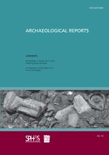
Archaeological Reports-London
Transforming Discoveries into Scholarly DiscourseArchaeological Reports-London, published by Cambridge University Press, is a prominent journal dedicated to advancing the field of archaeology, encompassing a comprehensive range of studies that delve into the rich tapestry of human history from prehistory to modern times. With an ISSN of 0570-6084 and an E-ISSN of 2041-4102, this journal has been a significant source of scholarly articles since its inception in 1955, serving as a crucial platform for researchers and academics alike. The journal is categorized in the third quartile for Archaeology and Arts and Humanities, and holds a prestigious position in the first quartile for Classics, reflecting its vital role in the scholarly community. With its esteemed ranking of Rank #45/170 in Classics and Rank #210/413 in Archaeology, it provides unparalleled insights and findings that shape contemporary archaeological discourse. Although not an open-access publication, the journal remains key for those who seek to enrich their understanding of archaeological practices and heritage conservation. Engage with Archaeological Reports-London to explore cutting-edge research that illuminates our understanding of past civilizations and informs future directions in the field.

Prilozi Instituta za Arheologiju u Zagrebu
Illuminating the archaeological landscape with impactful research.Prilozi Instituta za Arheologiju u Zagrebu is a prominent academic journal published by INST ARHEOLOGIJU, dedicated to advancing the field of archaeology and related historical studies. Operating in Croatia, this journal serves as a vital platform for scholars, researchers, and students to disseminate innovative research and insights within the realm of archaeology, with a focus on the rich cultural heritage of the region. The journal spans contributions from 2002 to 2011 and has ongoing publication since 2013, reflecting its commitment to contemporary archaeological discourse. With a growing reputation, it has achieved a Q3 ranking in the fields of Archaeology and Arts and Humanities, and a Q2 ranking in History, signifying its impact and relevance in the academic community. Although Open Access options are not available, the journal remains an essential resource for those pursuing in-depth knowledge and research in archaeology. Researchers can harness the journal's extensive scope to explore critical historical narratives and archaeological findings, solidifying its importance in both local and global contexts.